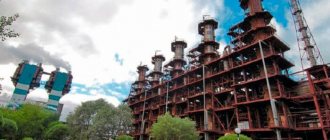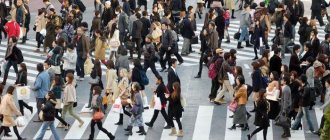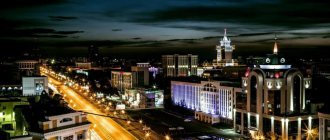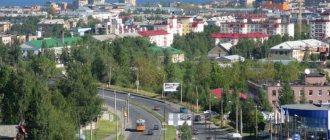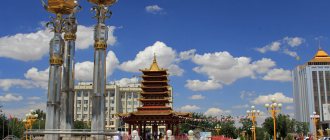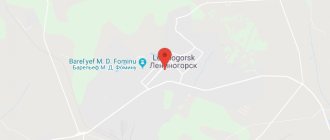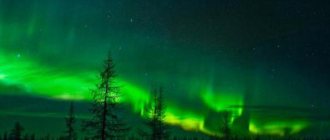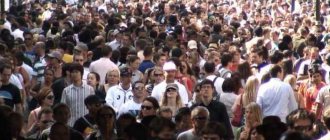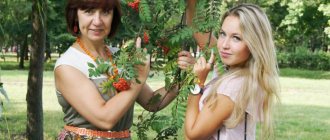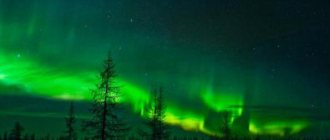Geographical location
But, before you start studying the population of Ulan-Ude, you need to figure out where exactly this settlement is located.
As mentioned above, Ulan-Ude is the capital city of the Republic of Buryatia. It is located in Eastern Siberia, in the western part of Transbaikalia, at a distance of about 100 km from the shore of the world's deepest Lake Baikal.
The large Selenga River flows through the city, dividing it into two parts. In addition, in the territory belonging to Ulan-Ude, another river flows into this river, the Uda.
The capital of Buryatia is located in a region with a sharply continental climate, characterized by warm summers and very cold winters.
The city occupies an area of 347.6 thousand square meters. km.
Budget and investments
The capital's budget revenues in 2015 will amount to 3.6 billion rubles. The third part of the expenses is aimed at developing education and preparing for the celebration of the 350th anniversary of the city. The budget deficit is planned to be kept within 10 percent of revenues of 300 million rubles. Interestingly, the city fathers plan to achieve a budget surplus by 2016. Primarily due to investment projects, both public and private. Since 2014, more than fifty promising projects have been implemented in the republic with a total capital investment of up to 250 billion rubles. The largest of them:
- construction of regional roads with a length of 40 kilometers;
- reconstruction of 200 kilometers of federal highways;
- reconstruction of 17 bridges with the construction of 9 entrances;
- construction of three autotourist complexes;
- construction of infrastructure for a tourist and recreational park with a complex of buildings in Podlemorye;
- fortification and hydraulic structures on the banks of the Selenga River;
- landscaping of urban areas and new buildings in the steppe zone;
- construction of production facilities for processing solid waste;
- expansion of the capital's airport runway;
- complex development of microdistricts of the capital in the southern direction.
Such large investments are aimed at improving the demographic situation in the region and increasing the living comfort of citizens. In the long term, it is calculated that the number of capital residents will double by 2027.
Story
To find out how the population of the city of Ulan-Ude was formed, you need to look into its history.
Since ancient times, the territory where Ulan-Ude is now located was inhabited by Buryat tribes. Russians began to actively penetrate these places in the 17th century. In 1666, they founded the village of Udinskoye on the site of the modern capital of Buryatia. It got its name because it was located at the very mouth of the Uda River. Its main function was to ensure the collection of yasak from the conquered Buryats. In 1678, the village acquired defensive structures and was transformed into the Udinsky fort. In 1689, the fort was turned into a real fortress, which was named Verkhneudinskaya.
In the 30s of the 18th century, a new name became widespread - Verkhneudinsk. In 1775, the fortress received the status of a city, which eight years later became the center of the district in the Irkutsk province. Gradually the city began to turn into the center of the Transbaikal region.
After the October Revolution, Verkhneudinsk changed its status several times. Initially, it became the administrative center of the Baikal province, and in 1920 it was the capital of the Far Eastern Republic, which was formally considered an independent state. However, the city remained in this status for only about six months. In 1923, it received the status of the capital of the Buryat-Mongolian ASSR as part of the RSFSR. In 1934, Verkhneudinsk was renamed Ulan-Ude, which means “Red Uda” in Buryat. That is, to the name of the river, which from time immemorial was present in the name of the city, the word “red” in the Buryat language was added, symbolizing the color of Soviet power. Thus, the name of the city simultaneously acquired an ideological and national Buryat connotation.
During Soviet times, the city grew and modernized, enterprises and factories were built. If initially the main population were Russian settlers, then in Soviet times more and more Buryats from other settlements in Transbaikalia moved to Ulan-Ude. The city's population became more ethnically diverse. In 1957, the Buryat-Mongolian Autonomous Soviet Socialist Republic was renamed the Buryat Autonomous Soviet Socialist Republic, and, accordingly, Ulan-Ude became the capital of this transformed autonomy. After the collapse of the USSR, in 1992, Ulan-Ude became the capital of the Republic of Buryatia, which is a subject of the Russian Federation. The city remains in this status today.
Sights and culture
The main attraction of the capital is a bronze monument to the leader of the world proletariat, an almost eight-meter tall head of Lenin cast in bronze, rising on a high, more than six meters, granite pedestal. Its production took 42 tons of non-ferrous metal.
In the vicinity of the city, the main shrine of Russian Buddhists was erected, the Ivolginsky Datsan Khambyn Sume. Thousands of pilgrims and tourists come here to explore the unique temple complex. Guests can stay at a hotel on the territory of the monastery.
The Rinpoche Bagsha Buddhist Center houses the largest gilded Buddha statue.
The ethnographic museum, whose holdings occupy more than 40 hectares, introduces guests to the history of the peoples of Transbaikalia. Thousands of copies telling about the historical development of Buryatia are collected in one open-air place.
Walking along Lenin Street, the pedestrian part of which was named the Buryat Arbat, you will see the symbolic coat of arms of the republic - a marble sculpture with bronze snakes, the Rod of the god of trade Mercury and a cornucopia.
The sculptural composition Beauty of the Angara is installed near the Opera and Ballet Theater. The dance composition is dedicated to the outstanding ballet masters of Buryatia.
On the central street of Kuibyshev there is the Trinity Church of the late 18th century, the shopping arcade of the merchant Kurbatov. Here you can walk around the estate of the tradesman Burlakov.
The largest museums, theaters, and exhibition halls of the republic are concentrated in the capital. The national song and dance theater Baikal successfully tours around the world.
Guests of the city enjoy visiting numerous museums:
- Museum of the History of Buryatia, where the richest collection of Buddhist religious objects is collected;
- Museum of Nature of the Republic;
- Art Museum;
- Museum of Applied Arts.
Dynamics of the number of residents
But Ulan-Ude did not always have such a number of residents. The population of this city periodically increased and decreased. Let's look at the demographics of the capital of Buryatia in dynamics.
The first data on the population of the future Ulan-Ud date back to 1695. At that time, 1981 inhabitants lived in the Verkhneudinsk fortress. In 1770, Verkhneudinsk already had 4,700 inhabitants. But then the numbers began to decline. So, in 1820 it was 3,000 inhabitants, and five years later - 2,024 inhabitants. But then the number of residents began to grow. In 1829 it amounted to 2972 people, and in 1851 it reached 3746. In 1856, the number of inhabitants again decreased to 3400 people, but already in 1860 it increased again and amounted to 4032 people. In 1890 the number grew to a record 5,223 people.
From that moment on, the city's population began to grow rapidly. Seven years later it already amounted to 8086 inhabitants, and by 1917 it reached the level of 21.6 thousand people. In 1931, the population of the city of Ulan-Ude had already reached 44.0 thousand people. The population increased especially rapidly in the 30s of the 20th century. This was due both to the forced relocation of those repressed to Siberia, including to the capital of Buryatia, and to the voluntary relocation of young people participating in the industrialization of the region. In 1939, the population of Ulan-Ude reached a record high - 125.7 thousand people. That is three times more than eight years before.
Subsequently, the upward trend in numbers continued. Thus, in 1956 the number of residents reached 158.0 thousand people, in 1970 - 253.6 thousand people, in 1980 - 303.2 people. The population growth continued until 1987, when the number of residents amounted to 351.0 thousand inhabitants. But in 1988, Ulan-Ude experienced the first decline in the number of residents in more than 100 years. Then the number of city residents dropped to 345.2 thousand people.
In subsequent years, a kind of “swing” was observed: the population either increased or decreased. Thus, in 1989 its population was 352.5 thousand people, in 1992 – 366.0 thousand people, in 1995 – 363.0 thousand. people, in 1997 - 370.0 thousand people, in 1998 - 366.1 thousand people, in 2002 - 374.9 thousand people. From 2003 to 2009 inclusive, there was an annual decrease in the population of Ulan-Ude residents. Thus, during this period it decreased by 359.3 thousand people. up to 340.2 thousand people
In 2010, there was a sharp increase in the number of residents of Ulan-Ude. The number was 404.4 thousand inhabitants. True, this did not happen due to natural growth, but due to the annexation of a number of suburban settlements to Ulan-Ude. But still, it should be noted that starting from 2010, the number of city residents began to grow steadily. In 2013, it reached 416.1 thousand people, and in 2016 the record was once again broken. The number of residents reached 430.6 thousand people.
Currently, the trend of demographic growth in Ulan-Ude continues.
Climate
Ulan-Ude can be described as a place with a humid climate. steppe climate (Köppen climate classification BSk
), bordering on a humid continental climate (
Dwb
bordering on
Dwc
). The climate is characterized by long, dry, cold winters and short but very warm summers. Precipitation is sparse and highly concentrated during the warmer months.
| Climate data for Ulan-Ude, 1981–2010 normals, extremes 1892–present. | |||||||||||||
| Month | Jan | Feb | Mar | Apr | May | Jun | Jul | Aug | Sep | October | But I | December | Year |
| Record high °C (°F) | −0.4 (31.3) | 7.9 (46.2) | 18.4 (65.1) | 28.7 (83.7) | 35.6 (96.1) | 40.0 (104.0) | 40.6 (105.1) | 39.7 (103.5) | 32.2 (90.0) | 24.7 (76.5) | 11.3 (52.3) | 5.2 (41.4) | 40.6 (105.1) |
| Average high °C (°F) | −17.9 (−0.2) | −10.9 (12.4) | −0.3 (31.5) | 9.8 (49.6) | 18.7 (65.7) | 24.5 (76.1) | 26.6 (79.9) | 23.6 (74.5) | 16.5 (61.7) | 6.9 (44.4) | −5.0 (23.0) | −14.5 (5.9) | 6.5 (43.7) |
| Daily average °C (°F) | −23.3 (−9.9) | −18.0 (−0.4) | −7.4 (18.7) | 2.4 (36.3) | 10.6 (51.1) | 16.9 (62.4) | 19.8 (67.6) | 17.1 (62.8) | 9.6 (49.3) | 0.7 (33.3) | −10.1 (13.8) | −19.3 (−2.7) | −0.1 (31.8) |
| Average low °C (°F) | −27.6 (−17.7) | −24.0 (−11.2) | −13.7 (7.3) | −3.7 (25.3) | 3.6 (38.5) | 10.5 (50.9) | 14.2 (57.6) | 11.8 (53.2) | 4.3 (39.7) | −4.0 (24.8) | −14.3 (6.3) | −23.2 (−9.8) | −5.5 (22.1) |
| Record low °C (°F) | −54.4 (−65.9) | −44.9 (−48.8) | −40.4 (−40.7) | −28.0 (−18.4) | −15.1 (4.8) | −3.9 (25.0) | 1.2 (34.2) | −4.0 (24.8) | −11.4 (11.5) | −27.9 (−18.2) | −38.0 (−36.4) | −48.8 (−55.8) | −54.4 (−65.9) |
| Average precipitation mm (inches) | 5 (0.2) | 3 (0.1) | 3 (0.1) | 6 (0.2) | 18 (0.7) | 43 (1.7) | 65 (2.6) | 68 (2.7) | 28 (1.1) | 8 (0.3) | 10 (0.4) | 9 (0.4) | 265 (10.4) |
| Average rainy days | 0 | 0.04 | 1 | 6 | 10 | 14 | 16 | 15 | 13 | 7 | 1 | 0 | 83 |
| Average snow days | 15 | 11 | 9 | 8 | 2 | 0.03 | 0 | 0 | 1 | 8 | 17 | 18 | 89 |
| Average relative humidity (%) | 77 | 75 | 66 | 53 | 49 | 57 | 64 | 69 | 68 | 68 | 76 | 78 | 67 |
| Average monthly sunshine | 115 | 155 | 225 | 248 | 287 | 288 | 270 | 247 | 211 | 167 | 113 | 92 | 2,418 |
| Source 1: Weather and Climate[18] | |||||||||||||
| Source 2: NOAA[19] | |||||||||||||
Ethnic composition
Now let's find out what nationalities people live in Ulan-Ude. The city is dominated by two nations - Russians and Buryats. There is an absolute majority of Russians in Ulan-Ude - 62.1%. There are also quite a lot of Buryats in the capital of the republic - 31.9%.
All other nations together make up only 6% of the total population. Among them are such ethnic minorities as Ukrainians, Tatars, Koreans and Chinese.
The procedure for issuing license plates in Russia
Let's consider the most common type of numbers in the Russian Federation:
These are the numbers that are installed on most cars.
At first glance, the number consists of a random sequence of letters and numbers. In fact, not everything is so simple here.
All numbers from 0 to 9 are used on license plates. However, unlike numbers, not all letters of the Russian alphabet can appear on license plates. This privilege is given only to those letters that have similar spellings in the Latin alphabet. Those. Only the letters A, B, E, K, M, N, O, R, S, T, U, X can be used on license plates.
You might have learned about this fact before, but the next thought will probably seem interesting to you. We will talk about the order in which the numbers are issued .
Numbers are issued in order (except for special series). However, the order in which the characters change in the number is far from normal perception. The symbols change not from right to left, but in a slightly different way - in a rather confusing sequence.
1. Most often, the third digit in the license plate changes (in the figure it is number 6). After the number T356OK the number T357OK will be issued.
2. The second most frequently changing character is the 2nd digit (in Figure 5). After the number T359OK the number T360OK will be issued.
3. The third most common symbol is the 1st digit (in Figure 3). After the number T399OK the number T400OK will be issued.
The numbers seem to be okay, but the same cannot be said about the letters.
4. The fourth most common symbol is the 1st letter (T in the picture). After the number T999OK the number U001OK will be issued.
5. The fifth most common symbol is the 3rd letter (K in the picture). After the number X999OK the number A001OM will be issued.
6. The sixth most common symbol is the 2nd letter (O in the picture). After the number X999OX the number A001PA will be issued.
The procedure is quite complicated, so if you didn’t understand it the first time, re-read points 1-6 again.
The symbols on the left side of the registration plate, which were discussed above, are responsible for vehicle numbers within a specific region. By the way, I inform statistics lovers that in one region no more than 1 million 726 thousand 272 car registration plates can be issued.
Religion
There are quite a lot of different religious denominations in the city of Ulan-Ude. Nevertheless, the vast majority of the city's residents profess Orthodox Christianity.
In addition, in Ulan-Ude there are representatives of such religious movements as Islam, Buddhism, Catholicism, various Protestant movements, Jehovah's Witnesses, as well as people who profess the original religion of the Buryats - shamanism.
Economy of the city
Employment of the population of Ulan-Ude is provided by both large enterprises and individual entrepreneurs. The largest organizations are aviation and locomotive and "Buryatnefteprodukt", a number of energy complexes (CHP-1, "Buryatenergosbyt", "Trunk Energy Networks", etc.).
In addition, the city has developed light and food industries, and there are a number of large trading enterprises. Although, of course, mechanical engineering remains the main direction of production in Ulan-Ude.
Employment center
For those who are still temporarily unemployed, the Employment Center offers its services. Ulan-Ude is a fairly large industrial city, so various vacancies are constantly available at the labor exchange. In addition, at the Center, if necessary, you can improve your qualification level or acquire a new profession.
What kind of work does the Ulan-Ude Employment Center provide? The vacancies here are very diverse. Workers are always in demand for low-skilled jobs. But at the same time, engineering and other technical specialties are in demand. But employers have a relatively low need for lawyers and economists.
People who have temporarily lost their jobs and are registered with the Employment Center receive unemployment benefits established by the state.
General characteristics of the population of Ulan-Ude
As you can see, Ulan-Ude is a constantly growing city. Currently, it is experiencing positive population growth dynamics. In addition, industry and other economic sectors are developed in the capital of Buryatia, which makes it possible to provide the city population with jobs as much as possible.
The vast majority of the inhabitants of Ulan-Ude are Russians and Buryats, with the former being numerically superior.
In general, the city of Ulan-Ude, like its residents, has quite optimistic prospects. This allows the population of the capital of Buryatia to look into the future with hope. But, of course, the further development of the city largely depends on the development of the Russian Federation as a whole.
Education
At the beginning of the 19th century, the population of the territory was not literate. There was only one public school, where they learned crafts and school basics. Today, a quarter of the capital's population are students of secondary specialized and higher educational institutions. There are over 80 secondary schools and the same number of kindergartens in the city. By 2016, according to the administration's plans, there will be no queues in preschool institutions in the city. New kindergartens are being built in housing complexes in the south-eastern part of the city.
More than 35 thousand young people study in 17 universities of the republic: 5 state universities and 12 branches. Specialists are trained:
- Buryat State University;
- East Siberian State University of Technology and Management;
- Agricultural Academy;
- Institute of Public Administration
- Agricultural Academy
- Institute of Railway Transport.
Young people receive secondary vocational education in 17 technical schools, colleges and schools.
The city has the Buryat Scientific Center of the Siberian Branch of the Russian Academy of Sciences, industry research institutes, and a fruit and berry experimental agricultural station.
